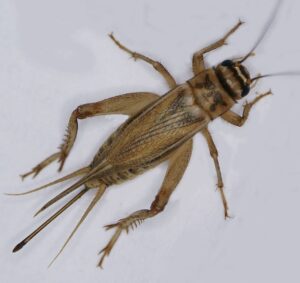Crickets

Cricket Biology
Cricket pest control is essential for managing these common insects, known for their pleasant chirping sounds, found throughout the United States. Typically, crickets live outdoors, feeding primarily on wild grasses, small weeds, and leaf litter. However, when these natural food sources become scarce, especially in late summer or fall, crickets may migrate in large numbers, invading homes and other buildings. Summer rains following a drought can also trigger these migrations.
Crickets can easily enter homes through gaps under doors that lack proper weather stripping or are misaligned. Once inside, they may cause damage by chewing holes in carpets, linens, draperies, clothing, and other valuable furnishings. They tend to prefer natural and synthetic fibers, especially those soiled with food, sweat, or grease.
The “songs” produced by crickets are made by rubbing two unique organs on the front wings of male crickets, known as the “file” and the “scraper.” Sexually mature males sing to attract females, who can “hear” them through specialized pits on their front legs. Different species of crickets can be recognized by their unique calling sounds, while females actively seek out singing males.
Crickets undergo an incomplete life cycle, consisting of an egg, nymph, and adult stage. They possess biting and chewing mouthparts. Some species have well-developed wings and can fly, while others are wingless. Crickets primarily stay on the ground, hiding during the day and actively foraging for food or mates at night. When they wander indoors, they seek hiding spots such as under furniture, appliances, and in dark corners of closets. While their songs are pleasant outdoors, they can be distracting and annoying when heard indoors. For detailed information on cricket biology and management strategies, visit the University of California’s IPM page on crickets.
Common Species of Crickets
| Common Name | Scientific Name |
|---|---|
| Field Cricket | Gryllus assimilis |
| House Cricket | Acheta domestica |
| Jerusalem Cricket | Stenopelmatus fuscus |
Cricket Pest Control
When it comes to maintaining a pest-free environment, effective cricket pest control is essential. Crickets can become damaging pests both indoors and outdoors. Complete control can be challenging during periods of migration, but combining sanitation and exclusion practices with selective chemical controls typically leads to effective management.
If crickets are a problem indoors, ensure that all floor-level door and window openings close tightly. Garage doors often do not seal properly, allowing crickets to enter. Inform occupants that re-infestation may occur if external openings are not adequately sealed.
When treating indoors, focus on floor-level hiding spots such as under upholstered furniture, boxes, mats, trash cans, and within closets and sink cabinets. Check under and inside any rodent bait stations that may be present. After applying a residual spray or dust, consider using a contact aerosol containing pyrethrins or synthetic pyrethroids to flush out remaining crickets from hard-to-reach areas. Additionally, using bright white lights around the residence can deter crickets.
To effectively manage crickets outdoors, lift boxes, flower pots, toys, and other items off the ground to access hiding places. Bait around the entire exterior when treating for field crickets, and spray the outside perimeter of the home with a residual pesticide as an important exclusion method. Implementing proper cricket pest control measures can help minimize damage and prevent re-infestation. If you need assistance, feel free to request pest control services from Traffic Pest Solutions today!
Cricket FAQs
- Are crickets insects?
- Yes, crickets are insects with three pairs of legs and three body parts.
- Do crickets have a complete life cycle?
- No, crickets have an incomplete life cycle known as gradual metamorphosis.
- Where do crickets lay their eggs?
- Crickets lay their eggs in the soil.
- Can crickets climb walls?
- Yes, crickets are adept climbers and can easily scale vertical surfaces.
- Can crickets fly?
- Some species, like common field and house crickets, can fly, while others, like Jerusalem crickets, are wingless.
- Do crickets have wings?
- Yes, common species of crickets possess wings. The chirping sound they produce comes from their wings.
- Can crickets jump?
- Yes, field and house crickets can jump like grasshoppers.
- How far can crickets jump?
- Common field and house crickets can jump about 3 feet, though this varies by species.
- Do crickets chirp?
- Only male crickets produce chirping sounds.
- Why do crickets chirp?
- Males chirp to communicate, attract females, and warn or threaten other males.
- How do crickets chirp?
- Male crickets produce chirps by rapidly rubbing special organs on their wings together.
- How do crickets mate?
- Males court females with their chirps, and upon approval, they mate to transfer sperm.
- What do crickets eat?
- Outdoors, crickets feed on ornamental plants and crops. Indoors, they eat fabrics like cotton, wool, and silk.
- Do crickets eat clothes?
- Yes, especially fabrics stained with food, sweat, or grease.
- What do Jerusalem crickets eat?
- They primarily attack tubers and bulbs, such as potatoes and gladiolus.
- Can crickets bite?
- While rare, crickets can produce a mild bite but are not aggressive.
- Where do crickets go in the winter?
- Field and house crickets overwinter in the egg stage, while Jerusalem crickets overwinter as adults.
- Do crickets sleep?
- Yes, crickets are nocturnal and sleep during the day.
- Can crickets tell the temperature?
- They cannot, but you can estimate the temperature by counting chirps: add 37 to the number of chirps counted in 15 seconds for the temperature in Fahrenheit.
